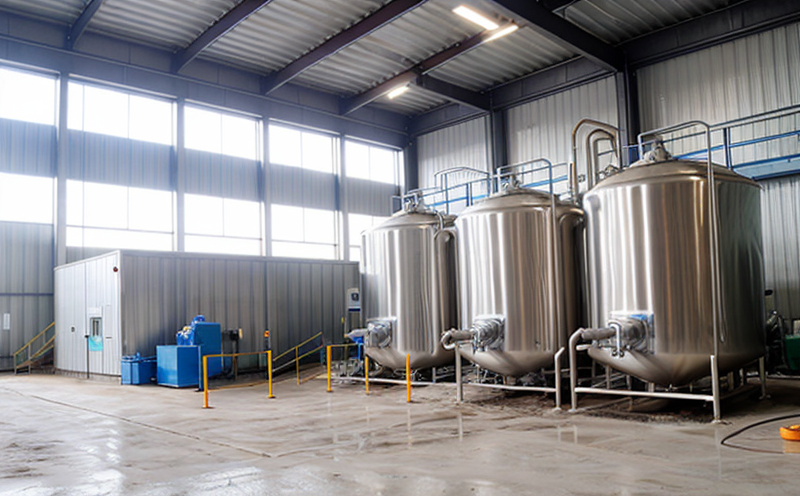ASTM D3559 Lead Test in Process Water
The ASTM D3559 standard is a critical method for detecting lead contamination in industrial process water. This test is particularly important for industries that rely on the purity and safety of their water sources, such as pharmaceuticals, electronics manufacturing, and food processing. The presence of lead can have significant health implications, especially when it leaches into potable or process water systems.
The ASTM D3559 Lead Test in Process Water is designed to ensure that the levels of lead do not exceed safety thresholds set by regulatory bodies like the World Health Organization (WHO) and the Occupational Safety and Health Administration (OSHA). The test procedure involves a series of steps aimed at accurately measuring the amount of lead present in water samples. This includes sample collection, preservation, filtration, and subsequent analysis using atomic absorption spectroscopy (AAS).
The importance of this testing cannot be overstated. In industries where water is used extensively for manufacturing or processing purposes, even trace amounts of lead can affect product quality and safety. For instance, in the electronics industry, lead contamination could result in poor soldering performance. Similarly, in pharmaceuticals, it could compromise the integrity of drug formulations.
The ASTM D3559 Lead Test is not just a compliance measure but also a preventive strategy to ensure that all processes are conducted under safe and controlled conditions. By adhering to this standard, industries can minimize risks associated with lead exposure for their employees and customers alike. Additionally, the results of these tests help in identifying potential sources of contamination within the water system, enabling timely corrective actions.
The methodology outlined in ASTM D3559 is precise and reliable, making it a preferred choice among laboratories specializing in industrial process water testing. The test procedure involves several key steps: collection of water samples from various points along the production line, preservation to prevent further contamination, filtration to remove suspended particles, and finally, analysis using AAS for accurate quantification.
One of the critical aspects of this test is the calibration of instruments used in the analysis. It’s essential that all equipment is regularly calibrated against known standards to ensure accuracy. This ensures that any detected lead levels are indeed due to contamination rather than instrumental errors. Calibration also helps maintain consistency across multiple tests, which is crucial for quality assurance and compliance.
The results from ASTM D3559 Lead Test in Process Water provide valuable insights into the overall health of industrial water systems. These findings can guide decision-making processes related to maintenance, upgrades, or even shifts towards more sustainable practices. For example, if high levels of lead are consistently detected over time, it may indicate a need for better filtration systems or changes in raw material sourcing.
The importance of this test cannot be overstated in ensuring the safety and quality of industrial processes that rely heavily on water resources. By leveraging ASTM D3559 Lead Test, industries can maintain compliance with international standards while also enhancing their reputation through transparency about product safety measures.
Scope and Methodology
The scope of the ASTM D3559 Lead Test in Process Water is extensive, encompassing various aspects of industrial water management. This includes not only detecting lead contamination but also ensuring that other heavy metals do not exceed safe limits. The methodology involves a series of rigorous steps aimed at achieving accurate and reliable results.
The first step in the process is sample collection. Samples are taken from different points along the production line to capture variations in water quality throughout the system. It’s crucial that these samples are representative of the entire process, which can sometimes be challenging due to the dynamic nature of industrial processes. Proper sampling techniques and equipment are essential to avoid introducing contaminants into the sample.
Once collected, the samples must be preserved carefully to prevent further contamination or degradation. Preservation methods vary depending on the type of metal being tested for; however, common practices include adding stabilizers or adjusting pH levels. After preservation, filtration is necessary to remove any particulate matter that could interfere with accurate measurement.
The core of the ASTM D3559 Lead Test lies in its analytical technique—atomic absorption spectroscopy (AAS). This highly sensitive method allows for precise quantification of lead concentrations down to parts per billion (ppb) levels. AAS works by shining a light through the sample, causing certain elements within the sample to emit characteristic wavelengths. By measuring these emissions, analysts can determine exactly how much lead is present.
Calibration plays a vital role in ensuring accurate results from this test. Regular calibration of instruments against known standards ensures that any detected lead levels are genuine and not artifacts resulting from equipment malfunctions. Additionally, maintaining consistent environmental conditions during testing helps minimize variability between tests conducted at different times or locations.
The final step involves interpreting the data collected through AAS analysis. Analysts use this information to assess whether the lead concentrations fall within acceptable limits according to relevant regulations such as those set by OSHA or ISO standards. If超标





